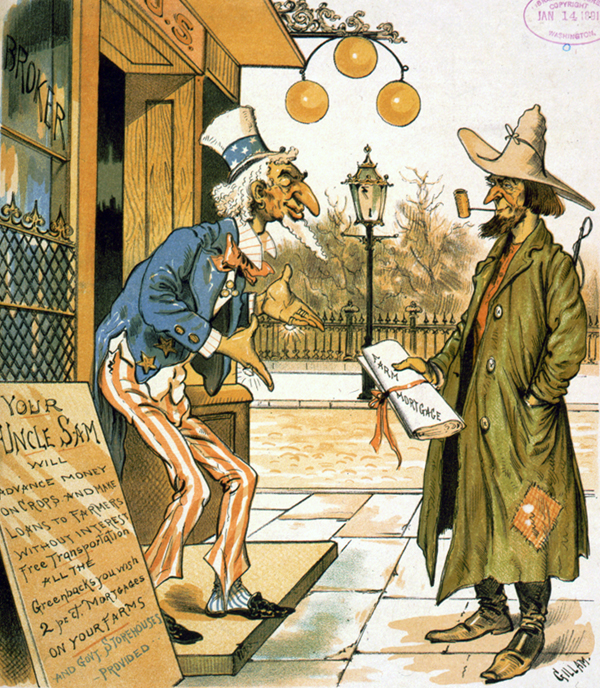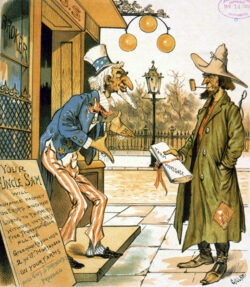Populism
In the late 1800s Americans witnessed a period of rapid industrialization and political transformation that drew some Louisianans to the Populist movement.
This entry is 8th Grade level View Full Entry

Courtesy of Library of Congress Prints and Photographs Division.
A political cartoon entitled “The New Uncle Sam," 1891.
In the late 1800s Americans witnessed a period of rapid industrialization and political transformation. America went from a rural agrarian society to an urban industrial society championed by big business. Despite modern conveniences like electricity and paved roads, not all Americans were pleased with the changes. During the early 1880s the Populist revolt arose, pitting those who felt victimized against those who benefited from the new order.
What challenges did the South face after the Civil War ended?
In the aftermath of the Civil War and Reconstruction, many southerners were plunged into poverty. The federal government refused to support legislation providing relief to the defeated rebels after war destroyed whole regions of the southern countryside. As the southern states went bankrupt, people who lost everything were forced to rebuild their shattered lives. Farmers in the South also had to pay taxes for all the years they had been absent during the war. Numerous proud and independent yeomen farmers were forced to leave their land as a result.
The multibillion-dollar system based on enslaved labor was destroyed by emancipation, and its destruction caused widespread economic instability. While formerly enslaved people welcomed their freedom, they had little opportunity to build wealth during slavery. In addition, they hadn’t been given the means to sustain themselves after emancipation, such as land, housing, or tools.
Many planters resorted to sharecropping, a system that allowed landless farmers, Black or white, to rent a plot of land from a landowner in exchange for a share of the crop. In exchange for food and other goods, the merchant placed a crop-lien, or a type of charge against the eventual value of the crop, ensuring his share at harvest. When sharecroppers went to settle at the end of a planting season, they typically found that the cotton or tobacco they produced didn’t cover the year’s debts, and they were forced to sign on for another season, a process that ensured a never-ending cycle of debt and poverty. Making matters worse, southern state governments, including in Louisiana, were controlled by Bourbon Democrats, whose conservative fiscal policies demonstrated far more concern for their own financial well-being than the plight of farmers.
How did the Populist Party begin?
As farmers in eastern Texas and other scattered areas began to organize, they realized they would have to initiate any relief opportunities themselves. In an increasingly corporate-driven world, the Farmers’ Alliance, led by the talented and energetic Charles Macune, educated and empowered farmers. Through the alliance, farmers were taught methods of improving productivity and encouraged to diversify their crops. In addition, the Farmers’ Alliance advocated for crop warehouses where farmers could store their crops until prices rose. The alliance soon realized that education alone wouldn’t suffice to overcome their situation; they would need to form a political movement as well.
Alliance members concluded that it would take a new party to promote their interests, since Bourbon Democrats and the nationally dominant Republican Party often appeared to be allies in exploitation. The idea of supporting any party other than the Democrats, who were perceived by white southerners as saving the South from carpetbaggers and scalawags, proved a bitter pill to swallow in states like Louisiana. By the late 1880s and early 1890s, utter desperation forced scores of Louisiana farmers, Black and white, to join the Populist Party. While some Farmers’ Alliance members like Macune were unable to abandon the Democrats, tens of thousands did. Major allies of southern farmers were farmers from the Midwest, who were also subjected to institutional neglect by the federal government. James B. Weaver was the first presidential candidate for the Populist Party in 1892. It was a respectable performance from Weaver, even though he didn’t win. As the farming crisis deepened in the early 1890s, more farmers turned to the Populist party.
What policy ideas did the Populist Party promote?
Central to the emerging Populist ideology was the subtreasury plan, which would enable the federal government to set up warehouse storage facilities and provide low-interest loans to farmers. Farmers would be able to store crops until prices rose, thus releasing them from crop-lien mortgages. As a result, more money would be in circulation. Following Louisiana’s unanimous vote against the subtreasury plan, coupled with growing evidence of corruption with the Louisiana Lottery, the Populist Party was officially born. Farmers in northern Louisiana were especially receptive. Homegrown leaders such as the Reverend Benjamin Brian, his son Hardy, and B. W. Bailey encouraged farmers to take a stand against injustice.
To gain a higher percentage of votes at the polls, Populist supporters reached out to the Negro Farmers’ Alliance. The Populist Party held picnics and barbeques where politicians called for cooperation among oppressed peoples to achieve reform. Despite this sentiment, the ruling elite increasingly viewed the Populists as threats to their way of life when they saw poor Black and white people working together. An economic depression hit the nation in 1893, and demands to expand the money supply skyrocketed. Louisiana Populists were determined to win the Fourth and Fifth Congressional Districts in 1894. The Populists lost each race despite spirited campaigning and numerous fraud allegations. Most observers said a fair election would guarantee Populist victory in upstate Louisiana and the Florida Parishes. The Populist movement stayed weak only in Acadiana, where Democrats portrayed them as anti-Catholic Protestants.
In the following years poor economic conditions and frustration with the Democratic Party’s response led to increasing numbers of Populist voters. During the election of 1896, Louisiana Populists made overtures to southern Louisiana sugar planters, who often supported Republicans but were also suffering from the depression. Both groups welcomed the thought of unseating Democratic Governor Murphy J. Foster—a shared purpose that would allow for a Populist-Republican fusion in the approaching gubernatorial campaign. John N. Pharr, one of Louisiana’s wealthiest men, was endorsed by the fusion ticket to cement the alliance.
What challenges did the Populist Party face?
It seemed that the Populists would prevail if they were able to keep Black and white farmers together with wealthy sugar planters. The Democrats began messaging that the Populists represented racial equality and social upheaval. One Shreveport Democratic paper went so far as to declare, “It is the religious duty of Democrats to rob Populists and Republicans of their votes. Rob them! You bet! What are we here for?” There was widespread violence across the state on Election Day 1896. When the Democratic-controlled state election commission completed the tally, it reported a narrow victory for Murphy J. Foster. In many predominantly Black parishes, the Populists didn’t receive a single vote, suggesting that the results had been tampered with or that Black men had been coerced into voting for the Democrats. Despite armed protests against the results, especially in north central Louisiana, Foster retained his position.
After the election of 1896, the Louisiana Populist movement lost much of its power. Because of sweeping changes to electoral law made during the 1897 legislative session, the electorate was significantly reduced. Between 1897 and 1898 Louisiana’s voter rolls shrank from 294,432 to 87,240, with Black voter registration falling from 130,344 to 12,902. By 1900, due to further restrictions enacted in the Constitution of 1898, that number had fallen to 5,320 voters of color. By 1900 the Populist movement was broken, and power was once again concentrated in the hands of wealthy Louisianans.
